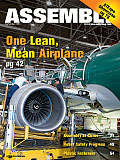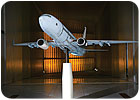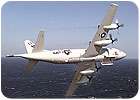
If ever there was a business that needed to continually reinvent itself, it’s the aerospace industry-this applies to assembly processes as much as the product itself. The dustbin of history is filled to brimming with airplane builders that failed to make the grade.
Back in the 1980s and 1990s, Boeing Co. (Chicago) very nearly made its own trip to the dustbin when it found itself confronting decreased demand and increased competition from arch-rival Airbus (Toulouse, France). Instead of giving in, though, the company responded by dramatically improving its efficiency and productivity through what it calls the Boeing Production System.
Central to this initiative has been an effort to emulate both Toyota Motor Corp. (Nagoya, Japan) and its lean manufacturing philosophy, with hundreds of Boeing employees making the trip to Japan to see how Toyota gets things done firsthand. Boeing also implemented a host of different Six Sigma methodologies to root out quality problems before they become major assembly issues.
The result has been a whole new way of doing business, whether it be helicopters, satellites or commercial jets.
At its Apache Longbow attack helicopter plant in Mesa, AZ, for example, the company was able to reduce the number of final assembly, integration and test hours per aircraft by 85 percent in the space of just 5 years. Similarly, the company has created a whole new supply-chain concept for its 787 Dreamliner, employing a network of global “partners” to both share risks and streamline final assembly.
At its plant in Renton, WA, the company implemented a moving assembly line to cut final production times for its record-breaking 737 jetliner-more than 5,700 have been produced since it first went into service in the late 1960s-down to a little over a week.
Most recently, Boeing has used this approach to create yet another moving assembly line to build the P-8A Poseidon, a new surveillance and anti-submarine airplane for the U.S. Navy. Intended to replace the Navy’s aging fleet of Lockheed P-3 Orion aircraft, the P-8A is a militarized version of the 737-800, the latest in a long line of 737 commercial variants. Ultimately, the Navy plans to purchase as many as 108 airplanes. Boeing hopes to sell the P-8A to a number of other allied navies as well.
As is the case with many other airplanes drafted for military service-like the Boeing 707, which was modified to create the E-3 Sentry airborne warning and control system, or AWACS-the Navy’s version of the 737 will be markedly different from the thousands of 737s currently in service carrying civilian passengers.
However, Boeing is leveraging its production system to make the transition as efficient as possible, coordinating its Commercial Airplanes and Integrated Defense Systems (IDS) divisions in a way that would have been unthinkable in the past. It is also taking full advantage of the experience it has already acquired building 737s to make ramping up the new program that much easier, thereby maximizing both quality and profitability.

Despite their differences, Boeing uses nearly identical lines to assemble both its 737 commercial jetliner and the P-8A.
Right the First Time
In terms of specific production initiatives, arguably the most important is simply that Boeing plans to manufacture each P-8A airframe to military specification the first time around, as opposed to bringing it up to spec further down the line.Historically, whenever it modified an airplane for military use, Boeing’s Commercial Airplane division would first build a standard civilian airframe, then fly it to an IDS facility where workers would make the necessary changes: modifications that could include everything from inserting reinforced framing to cutting holes for things like torpedo bays and antennas-which in the case of the P-8A number about 100.
With the P-8A, however, Boeing’s commercial side is building an airframe that is already to spec, complete with things like weapons bays, auxiliary fuel tanks and tougher skins on the wings and fuselage. As a result, when IDS receives the plane it can immediately set about the task of installing and testing the requisite hardware and software, as opposed to doing things like making a bunch of new holes. This represents a tremendous increase in efficiency given that approximately 75 percent of the P-8A’s airframe is different from that of a conventional 737.
Complementing this increased processing efficiency is that fact that the P-8A is being assembled on a line that is remarkably similar to those being used to build the regular 737. According to P-8A operations director Perry Moore, the new line No. 3-like the second 737 moving line the company installed in 2007-is shorter than the first 737 moving line because of space constraints. But, the actual work being done there, things like wing joins, fuselage integration, landing gear and engine installation, is essentially the same.
The new line also employs the same self-guided tuggers to pull each airplane from station to station; the same system of yellow and purple lights to identify the location of any production problems that might occur; and the same kitting and line-side support stations to keep the lines moving smoothly. In fact, Moore says that during ramp up the company performed a check-fit on line No. 3 with a completed commercial Next-Generation 737 to confirm the accuracy of the tooling needed to build the Poseidon.
“All three lines use the same basic processes for how the major sections of the airplane are joined,” he says. “The use of kitting and centralized, problem-solving shipside support stations at each line position is also identical.”
“Moving lines are proven to enhance the quality and efficiency of production processes,” agrees P-8A program manager Mo Yahyavi. “Boeing has found that moving lines drive out waste and make it easier for employees to solve emergent issues. Problems are more visible, and any employee can stop the line at any time, mustering the help of engineers and other support personnel.”

With every new aircraft program, Boeing is able to further refine its design and processing capabilities.
Human Resources
Of course, the best equipment in the world means little if you don’t have qualified people to operate it, and with this in mind the P-8A is getting plenty of help from Boeing’s existing knowledge base. Moore, for example, has spent half of his 25 years with Boeing working on 737s, and the new line is replete with other 737 veterans.“From the outset, P-8A program manufacturing employees were drawn from 737 final assembly and other Boeing commercial airplanes operations,” Moore says. “The P-8A program routinely [borrows] the manufacturing skills and abilities from mechanics, quality inspectors and other supporting skills from the 737 program’s assembly lines No. 1 and No. 2 to fill short-term, emergent final assembly requirements.”
Moore adds that close cooperation between engineers and operators on both the commercial and IDS sides of the program has also been critical to the success of the program.
“The program has been able to rapidly move from design to build to completion of final assembly and on to preflight activities due to the outstanding working relationships of our ‘one team’ operating principles, which combine the strengths and unique cultures of both Commercial Airplanes and Integrated Defense Systems,” he says. “Each airplane model comes together differently and is in a different phase of the [company’s] lean manufacturing journey. As a result the lessons learned from each program contribute to the body of knowledge available to new programs, such as the P-8A Poseidon.”
In this same vein, Moore notes that Boeing’s use of digital design technology has been critical in allowing design and production engineers to work together, no matter how far apart they might be.
For example, the fuselage for each P-8A is built by Spirit AeroSystems (Wichita, KS), the same company that builds the fuselage for each 737. Shipped by rail to the Boeing final assembly plant in Renton, each P-8A fuselage arrives already equipped with the basic apertures, bays and framing necessary to accommodate the airplane’s military hardware and other equipment. According to Moore, implementing these kinds of design changes at such a distance would have been impossible without the help of CATIA and other CAD/CAM software.
Interestingly, like the Boeing Production System, this emphasis on digital design is another result of the company’s efforts to reinvent itself in the 1980s-no big surprise then that it is also a big part of why Boeing is headed anywhere but the dustbin in this the first decade of the 21st century.

Boeing’s new P-8A will replace the Navy’s P-3C Orion turboprop surveillance airplane (above), which has been in service since the late 1960s.
Sidebar: The Navy's Latest Sub-chaser
The P-8A Poseidon is a long-range, antisubmarine, anti-ship surveillance and reconnaissance aircraft intended to replace the U.S. Navy’s existing fleet of P-3C Orion turboprop airplanes. Built by Lockheed Martin, the P-3C Orion fleet currently numbers 196 airplanes and has been in operation since the late 1960s.A modified 737-800, the P-8A is being built by Boeing in partnership with CFM International, Northrop Grumman, Raytheon, GE Aviation and Spirit AeroSystems. Flight-testing of the P-8A is scheduled to begin in 2009, with the first Poseidon entering service in 2013. In all, the Navy plans to purchase 108 P-8As.
The P-8A will have a crew of nine and a range of approximately 1,200 nautical miles. This will allow it to spend four hours on-station without refueling. In addition to its surveillance and communications equipment, the P-8A will carry a number of different weapon types, including depth charges, torpedoes and free-fall bombs.